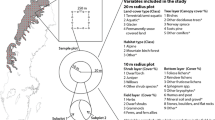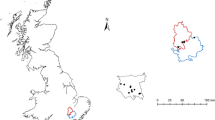Summary
The vegetation of a permanent quadrat situated in a Calluno-Genistetum typicum community has been analysed every year from 1955–1964 (cf. Vegetatio Vol. X, Fasc. 1, 1961 and Vol. XIII, Fasc. 4, 1966) and again from 1965 to 1969.
Calluna vulgaris, which from 1955 to 1959 still covered 85–95 % of the area, decreased to 30–55 %. This was due to disease or perhaps was a result of sheep grazing. On the other hand,Betula pendula, which had appeared first in 1961, has increased continually in the permanent quadrat. This increase is probably due to the sheep, who avoid the young trees ofBetula pendula.
The number and cover of the other plants fluctuated due to variations in climate or the sheep grazing.
Similar content being viewed by others
Literatur
Beyer, H., 1968 — Versuche zur Erhaltung von Heideflächen durch Heidschnucken im Naturschutzgebiet „Heiliges Meer”.Natur und Heimat. Münster (Westf.), 28: 145–149.
Westhoff, V., 1960–61 — Het beheer van Heidereservaten.Natuur en Landschap, 14: 4.
Westhoff, V., 1961 — Het beheer van de heidereservaten. Jubileumnummer, 34, Nr. 1–3 vanhet maandschrift der Vereniging voor Natuur- en Stedenschoon. V.Z.W. Antwerpen.
Author information
Authors and Affiliations
Rights and permissions
About this article
Cite this article
Runge, F. Jährliche Schwankungen Der Individuenzahl In Einer Nordwestdeutschen Trockenen Heide III. Plant Ecol 23, 71–76 (1971). https://doi.org/10.1007/BF02350613
Issue Date:
DOI: https://doi.org/10.1007/BF02350613




